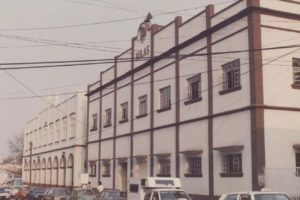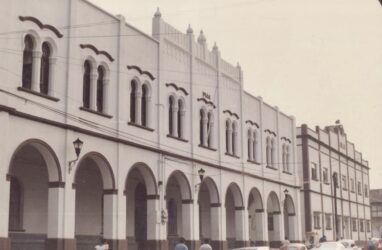
Ex ICACH.
*the Unicash It is a public institution of higher education, socially and historically defined, whose purpose is to train professionals and generate knowledge in the fields of health, natural sciences, social and administrative sciences, agricultural sciences and engineering, as well as to carry out research and extension work aimed at improving the quality of life of the Chiapas community in general.
On January 31 of this year 78 years old To create the Institute of Sciences and Arts of Chiapas (ICACH), by then Governor Juan Manuel Esponda, in the building built in 1944 by former Governor Rafael Pascasio Gamboa, for the University of Chiapas. Today, it is the University of Sciences and Arts of Chiapas (UNICACH).
Few institutions of higher learning were established in Chiapas in the early years of the conquest. The Church established the School of Theology and three centuries later, secular education began at the School of Law in Ciudad Real in the mid-nineteenth century.
Unicash indicated that the roots of the study center go back to that century, because it is part of the Industrial School of Chiapas, established in 1893 by Governor Emilio Rabassa Estebanel, a writer and jurist, who had transferred the powers of government to Tuxtla Gutierrez shortly before.
In 1897, the Industrial School of Chiapas became the State Institute of Arts and Crafts and in 1900, it took on a new vocation by forming the Military Industrial School, which was installed in a building built to house it, on the land where the center is located. Cultural Jaime Sabines of the State Council for Cultures and Arts of Chiapas (CONECULTA).
For 1926, the institution became the state co-educational and preparatory normal school. This is the background of UNICACH, although it is from history, it has several years of presence in tertiary and secondary education in the state.

Unicash
In this sense, Governor Esponda in 1945 issued the decree establishing the ICACH. There are preparatory and regular education schools that come with rural normal, superior, and postgraduate specializations.
For its performance, the building that is currently the seat of the high school, on the Second South Avenue of the capital, was built. In 1981, Governor Juan Sabines Gutierrez recognized it as an institution of higher education.
Additionally, in 1951, ICACH was a founding member of the National Association of Universities and Institutions of Higher Education (ANUIES). This was another great time for the organization.
Since then, its faculty has been made up of brilliant professors, among them: Andrés Fàbregas Roca, a Spanish republican, humanist who offered his talent in those classrooms and beyond as he influenced the cultural enrichment of society.
During Governor Francisco José Grajales’ four-year term, the arts district was consolidated into the institute, adding the Schools of Music, Dance, Composition, and Performing Arts. Similarly, in his government, the Chiapas Ateneo de Ciencias y Artes was established, the Chiapas Prize was created and he invited national and foreign scholars to join the life of the state.
The above, for the creation of important scientific centers such as the Garden and the Botanical Institute, the meritorious works of Dr. Faustino Miranda, also supported Professor Miguel Álvarez del Toro for the development of the Zoological Institute of Chiapas in Madero Park.

Legendary ICACH. Courtesy: Chiapas Alert
The building that currently occupies the rectory, which was designed as the Palace of Culture, was also constructed. But, it was not until 1988 when the building housed a cultural unit, the Instituto Chiapas de Cultura, and upon joining the ICACH, that the dance school continued the Bonampak ballet experiment founded by virtuosos of international stature.
The School of Plastic Arts, founded by teacher Jorge Olvera in 1945, has trained local painters and engravers of national and international dimensions such as Franco Lázaro Gómez. The cultural baggage left behind by General Grajalis is extensive and is a reference point for contemporary culture.
Later, under the direction of Maestro Luis Alaminos, plastic artists of the stature of Reinaldo Velazquez got their initial training. Luis Alaminos has also maintained the performing arts course at ICACH with distinction and success on a national level, and his teachings have been the roots of such a memorable theatrical group as the Junior 15.
Beginning in 1981, positions in topographical engineering, dentistry, psychology, nutrition, and biology were created. During those same years, poet and lawyer Daniel Robles Sasso directed the foundation. The fact is relevant because in addition to the human, artistic and intellectual quality of Daniel Robles, the first director was a student at the same institute.
While, in 1989, Governor Patrocinio González Garrido strengthened the Arts District of the Institute, adding the Schools of Music, Dance, Plastic Arts and Performing Arts, established by the government of General Grajales. Each of them contributed the baggage they had acquired in their previous lives.
On January 31, 1995, Governor Eduardo Robledo Rincón, through Decree No. 136, approved by the State Congress, transformed the former Institute into the University of Sciences and Arts of Chiapas.
In 1995, the artistic infrastructure of the old Chiapas Institute of Culture became the Directorate of Cultural Extension of Unicash. Later, in the same year, the old Palace of Culture became the seat of the parsonage.
One of the first academic missions as a university institution was the creation of the Postgraduate Center for Mexico and Central America (CESMECA), whose mission is postgraduate research and education. In 1996, a bachelor’s degree in music and a master’s degree in social psychology were confirmed. The University Information and Documentation Center (CUID) was established in 1998.
Related


“Creator. Devoted pop culture specialist. Certified web fanatic. Unapologetic coffee lover.”
